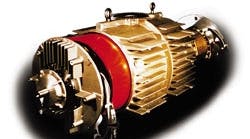Whether making semiconductor chips or mixing ingredients for food and beverages, it’s important for equipment to operate without interruption. If a motor loses power by even a fraction due to utility power supply fluctuations or load changes, the result is usually a destroyed batch.
In the U.S., utility power is fairly clean, but voltage surges and sags still occasionally occur. Harmonics can also play havoc with motor and microprocessor performance. While solutions exist, so far most are less than ideal.
Written-Pole technology may supply a better answer. Thanks to their unique design, they can ride through most power interruptions, regardless of cause.
Developed originally by engineers at Precise Power Corp., Palmetto, Fla., the initial Written-Pole motors were singlephase and a few horsepower. The latest designs now include single-phase motors, ranging from 10 to 75 hp, and three-phase to 1,000 hp.
Write on
Unlike other ac motors where the magnetic poles are fixed, Written-Pole motors can have a varying number of poles. The importance of this flexibility shows up in how each type reacts to a power interruption. Without constant power, fixed pole motors quickly lose synchronism, resulting in a drop in speed followed by a stop altogether.
A loss of power causes Written-Pole motors to lose speed too. However, the external rotor limits the speed decrease to less than 1% per second, allowing the motor to coast through power outages of up to 15 seconds.
Once power is restored, a special excitor winding changes pole placement on the rotor while the motor is operating. These new pole placements maintain electrical synchronism.
If a Written-Pole machine is operating as a generator, then a microprocessor commands the system to maintain constant frequency and voltage regardless of machine speed. Combining two Written-Pole machines, one operating as a motor and the other as a generator, results in an uninterruptible power supply and eliminates the need for external batteries. Such a system will ride through 12 to 15 seconds of power interruption, which is usually sufficient time to start a backup generator if power will be out for a longer time period.
Two factors enable such pole flexibility. The rotor, either internal or external, is covered in a continuous layer of ferrite material. The stator, which is comparable to a typical induction motor, has an additional winding that functions as an excitor pole. When energized, it develops a powerful magnetic field that can pulse as often as 60 times a second. Each pulse induces, or “writes” a magnetic pole onto the ferrite material in a pattern that is magnetically synchronous with the rotating stator field.
At startup, these motors’ pole placement is the same as a standard induction motor. Writing can begin once the motor reaches 80% speed. Then, at a predetermined speed, writing ceases and the motor functions as a permanent magnet synchronous motor. Should speed drop due to power fluctuations or load change, the system automatically reinitiates writing to maintain the desired output.
The single phase
The written-pole method started as a solution to single-phase needs. Most single- phase ac motors were limited to 10 hp or less because of the current draw needed for start-up. Inrush current can often be six to nine times higher than running current. Even EPAct high-efficiency motors tend to have a start-up current that’s ten times running current. High currents raise rotor temperature, plus they can cause voltage sags or surges on utility power, and even throw harmonics into the utility power system.
Because of their design, Written-Pole motors draw about two times normal current at start-up. Less heat builds up, due to the lower starting current, giving these motors a high load capacity and the ability to accelerate high inertia loads.
Special thanks to TECO-Westinghouse and Precise Power Corp. for information for this article.
